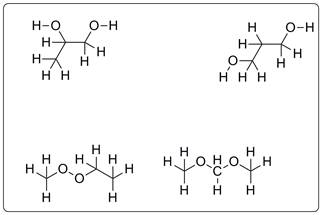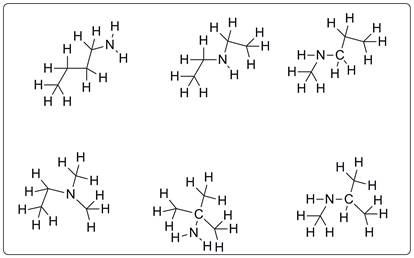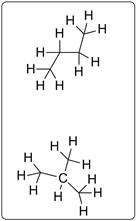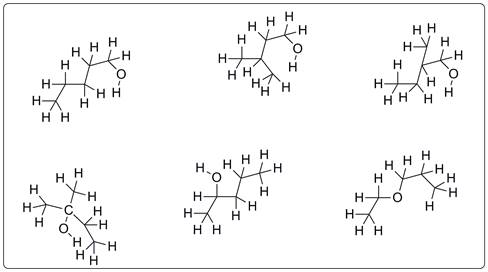
Concept explainers
(a)
Interpretation :
HONC 1234 rules must be followed to draw the structures of the given molecular formula C3H8O2.
Concept Introduction :
HONC 1234 rule is the basic rule for drawing organic molecule. The rule states that H, O, N and C generally form 1, 2, 3 and 4 bonds respectively.
(a)
Explanation of Solution
Structures possible for C3H8O2 are given below.

All the compounds are drawn for C3H8O2 which represents alcohols with two hydroxyl groups, peroxide and two ether groups.
b)
Interpretation :
HONC 1234 rules must be followed to draw the structures of the given molecular formula C4H11N
Concept Introduction :
HONC 1234 rule is the basic rule for drawing organic molecule. The rule states that H, O, N and C generally form 1, 2, 3 and 4 bonds respectively.
b)
Explanation of Solution
Structures possible for C4H11N are given below.

All the compounds are drawn for C4H11N which represents
c)
Interpretation :
HONC 1234 rules must be followed to draw the structures of the given molecular formula C4H10
Concept Introduction :
HONC 1234 rule is the basic rule for drawing organic molecule. The rule states that H, O, N and C generally form 1, 2, 3 and 4 bonds respectively.
c)
Explanation of Solution
Structures possible for C4H10 are given below.

All the compounds are drawn for C4H10 which represents
d)
Interpretation :
HONC 1234 rules must be followed to draw the structures of the given molecular formula C5H12O2.
Concept Introduction :
HONC 1234 rule is the basic rule for drawing organic molecule. The rule states that H, O, N and C generally form 1, 2, 3 and 4 bonds respectively.
d)
Explanation of Solution
Structures possible for C5H12O are given below.

Few of the compounds for C5H12O are drawn which represents alcohols and ethers.
Chapter U2 Solutions
Living by Chemistry
Additional Science Textbook Solutions
Chemistry: Structure and Properties
General, Organic, and Biological Chemistry (3rd Edition)
General Chemistry: Atoms First
Chemistry: A Molecular Approach (4th Edition)
Chemistry: Structure and Properties (2nd Edition)
Organic Chemistry (9th Edition)
 ChemistryChemistryISBN:9781305957404Author:Steven S. Zumdahl, Susan A. Zumdahl, Donald J. DeCostePublisher:Cengage Learning
ChemistryChemistryISBN:9781305957404Author:Steven S. Zumdahl, Susan A. Zumdahl, Donald J. DeCostePublisher:Cengage Learning ChemistryChemistryISBN:9781259911156Author:Raymond Chang Dr., Jason Overby ProfessorPublisher:McGraw-Hill Education
ChemistryChemistryISBN:9781259911156Author:Raymond Chang Dr., Jason Overby ProfessorPublisher:McGraw-Hill Education Principles of Instrumental AnalysisChemistryISBN:9781305577213Author:Douglas A. Skoog, F. James Holler, Stanley R. CrouchPublisher:Cengage Learning
Principles of Instrumental AnalysisChemistryISBN:9781305577213Author:Douglas A. Skoog, F. James Holler, Stanley R. CrouchPublisher:Cengage Learning Organic ChemistryChemistryISBN:9780078021558Author:Janice Gorzynski Smith Dr.Publisher:McGraw-Hill Education
Organic ChemistryChemistryISBN:9780078021558Author:Janice Gorzynski Smith Dr.Publisher:McGraw-Hill Education Chemistry: Principles and ReactionsChemistryISBN:9781305079373Author:William L. Masterton, Cecile N. HurleyPublisher:Cengage Learning
Chemistry: Principles and ReactionsChemistryISBN:9781305079373Author:William L. Masterton, Cecile N. HurleyPublisher:Cengage Learning Elementary Principles of Chemical Processes, Bind...ChemistryISBN:9781118431221Author:Richard M. Felder, Ronald W. Rousseau, Lisa G. BullardPublisher:WILEY
Elementary Principles of Chemical Processes, Bind...ChemistryISBN:9781118431221Author:Richard M. Felder, Ronald W. Rousseau, Lisa G. BullardPublisher:WILEY





